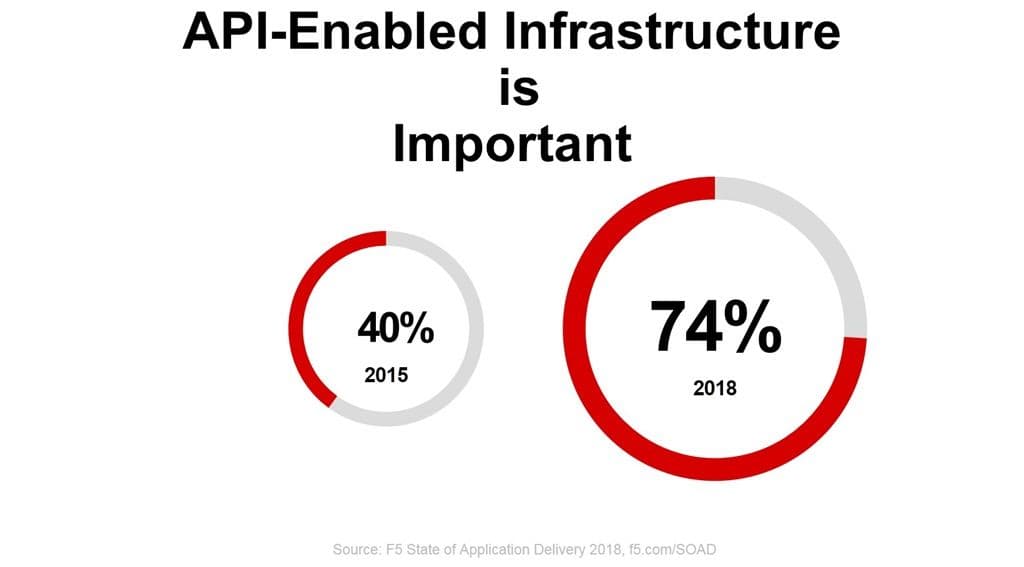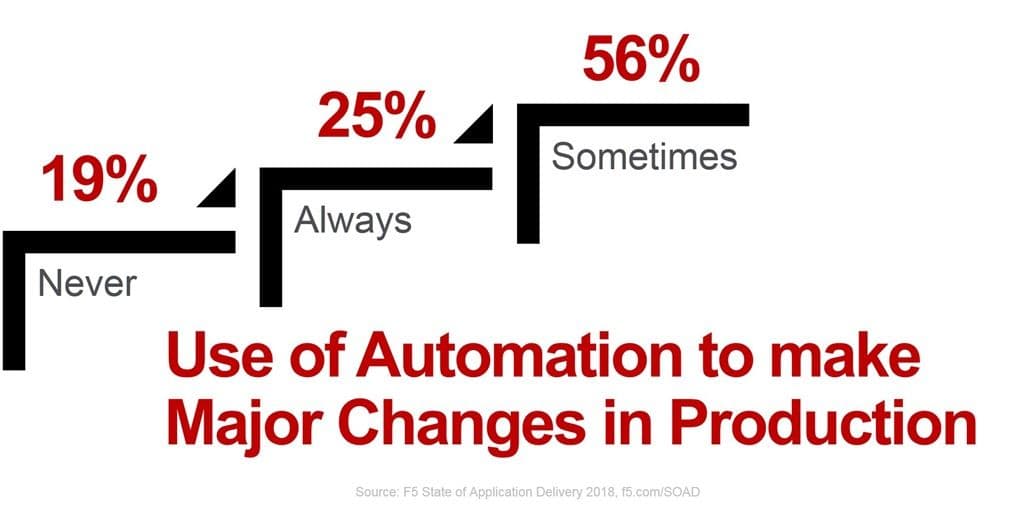
As an IT polymath who loves programming languages as much I do protocols and wire captures, the blurring of the lines between the two required of automation and orchestration makes me giddy.
For four years we’ve been tracking how respondents to our State of Application Delivery survey perceive API-enabled infrastructure and related technologies. In that time, the percentage of folks who identify programmability of infrastructure as important (scoring 4 or 5 on a scale of 5) has nearly doubled. In 2015 less than half – 40% – told us it was important. This year a staggering 74% tagged it as important.
Perhaps we shouldn’t have been surprised by this given the results of a survey we conducted in 2017 on the topic. In that exploration of the perceptions of DevOps and NetOps, both groups unilaterally agreed that automation of the production pipeline was important.
But perceptions are just opinions. Actual usage is another.

What we found in this year’s survey was that automation is pervasive across every region, every industry, and every size of organization. While no one has reached 100% (and probably won’t), there is a lot more automation going on in production than perhaps anyone realized.
In fact, 25% of respondents told us they always use automation to make major changes in production. 60% sometimes use automation to make minor changes in production. In fact, changes in production were, on the whole, more likely to see use of automation than was its use in incident response. More than one in four (26%) said they never use automation for incident response and only 22% told us they always do. The variability in dealing with what are likely unpredictable events makes this unsurprising. Automation relies, in part, on a clearly defined set of tasks and steps that bind them together into an operational process. That makes things like changes in production – whether major or minor – a better fit for the codification of those processes. Incident response? Not so much.
There is, it seems, an awful lot of automation going on inside data centers of all shapes and sizes and industries.
You might wonder what they’re using to implement all this automation. In years past we’ve lumped a lot of tools and toolsets and frameworks together in one question. But that’s not reasonable as automation really takes hold because there are several different aspects of automation that really need to be understood to understand what’s going on:
1. Languages and toolsets. These are what NetOps and IT uses for command and control of automation. It includes tools like Ansible (20%) and Vagrant (5%), as well as frameworks like Puppet (19%) and Chef (16%). Of them, the clear winner is good old Python scripts, with 39% of respondents choosing to roll their own to automate IT.
2. Network automation. With an average of 16 different application services residing in the data path and requiring deployment, configuration, and ongoing management to support the safe delivery and scale of applications, most organizations are going to turn to systems like Cisco ACI (48%), VMware (65%) and OpenStack (26%). All three saw considerable gains year over year. Unsurprising in an environment where 55% of organizations are turning to automation and orchestration as a result of digital transformation efforts.
3. Container orchestration environments (COE). These emerging technologies continue to make waves and it seems clear that their usage to scale containerized applications is inevitable. Of those we asked about, Docker Swarm took the lead with 27% of respondents, followed by Red Hat OpenShift with 21% and Kubernetes coming in a strong third at 16%. Only 48% told us they are not using anything at this time.
Unsurprising to me, the number of these tools and frameworks in each organization is decreasing. That means we’re seeing deliberate use of automation tools and toolsets in what is certainly a strategic effort to standardize. Better soon rather than later before chaos reigns and IT bows under the weight of the same kind of technical and architectural debt app developers have been struggling with for years. In fact, 50% of respondents use only a single network automation framework. Of those, 8% rely on Cisco ACI, 5% on Open Stack, and 19% on VMware.
This is still a very fluid and evolving market – if one can call it a market and not a movement. The invasion of DevOps approaches into production and pressure from the business are making IT move faster. NetOps are adopting and embracing automation and all that entails. We expect to see greater use of automation as IT continues its digital transformation journey to provide the business with a solid digital foundation upon which to build new apps and explore new opportunities.
For more insights on digital transformation, multi-cloud, application services, security, and the continuing NetOps transformation, feel free to grab your own copy of our 2018 State of Application Delivery report and follow along on the Twitters with @f5networks and/or the hashtag #soad18. And stay tuned – we’ll have more insights (including data and perspectives not in the report) in forthcoming blogs.
About the Author

Related Blog Posts

Nutanix and F5 expand successful partnership to Kubernetes
Nutanix and F5 have a shared vision of simplifying IT management. The two are joining forces for a Kubernetes service that is backed by F5 NGINX Plus.

AppViewX + F5: Automating and orchestrating app delivery
As an F5 ADSP Select partner, AppViewX works with F5 to deliver a centralized orchestration solution to manage app services across distributed environments.

Build a quantum-safe backbone for AI with F5 and NetApp
By deploying F5 and NetApp solutions, enterprises can meet the demands of AI workloads, while preparing for a quantum future.

F5 ADSP Partner Program streamlines adoption of F5 platform
The new F5 ADSP Partner Program creates a dynamic ecosystem that drives growth and success for our partners and customers.
F5 NGINX Gateway Fabric is a certified solution for Red Hat OpenShift
F5 collaborates with Red Hat to deliver a solution that combines the high-performance app delivery of F5 NGINX with Red Hat OpenShift’s enterprise Kubernetes capabilities.
Phishing Attacks Soar 220% During COVID-19 Peak as Cybercriminal Opportunism Intensifies
David Warburton, author of the F5 Labs 2020 Phishing and Fraud Report, describes how fraudsters are adapting to the pandemic and maps out the trends ahead in this video, with summary comments.
